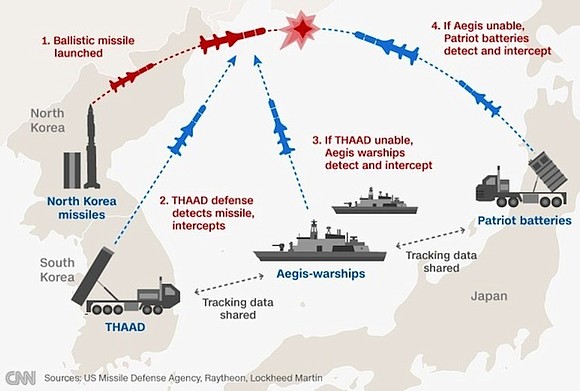US, South Korea, Japan Start Drills Off North Korea
CNN/Stylemagazine.com Newswire | 3/14/2017, 1:35 p.m.

By Brad Lendon
CNN
(CNN) -- The US, Japan and South Korea sent a pointed message to North Korea on Tuesday, dispatching high-tech missile defense ships to the same area where Pyongyang fired four missiles just eight days ago.
Aegis warships from the US, South Korea and Japan began exercises Tuesday to improve their capability to shoot down enemy ballistic missiles, the US Navy said in a statement.
The US Navy called the two-day drills "a trilateral missile warning informational link exercise."
"The exercise will employ tactical data link systems to trade communications, intelligence and other data among the ships in the exercise," a statement from the US Navy's 7th Fleet in Japan said.
China's Foreign Ministry reacted sternly Tuesday afternoon, calling on all sides to end "a vicious cycle that could spiral out of control."
"North Korea has violated UN Security Council resolutions banning its ballistic missile launches; on the other hand, South Korea, the US -- and now Japan -- insist on conducting super-large-scale military drills," Chinese Foreign Ministry spokeswoman Hua Chunying said.
In response, Pyongyang accused the US of preparing a "preemptive strike", according to North Korea's Korean Central News Agency, KCNA,
"If they infringe on the our sovereignty and dignity even a bit, our army will launch merciless ultra-precision strikes from ground, air, sea and underwater," read the statement.
Analysts said the Japan-South Korea cooperation in Tuesday's exercise was important.
In the past, South Korea has been accused of not "play(ing) nice with Japan on a variety of military and intelligence issues," according to Corey Wallace, a Japan security expert at Freie University in Berlin.
He said that was considered a liability when it comes to countering the North Korean threat.
A US Navy 7th Fleet spokesman said the current exercises are the third in a series designed to improve ballistic missile defenses among the US, Japan and South Korea.
"The partnership between both nations and the US is critical in deterring future North Korean acts of aggression," Lt. Paul Newell said in an email to CNN.
Carl Schuster, a professor at Hawaii Pacific University and former director of operations at the US Pacific Command's Joint Intelligence Center, said both Pyongyang and Beijing would have reason to be wary of better military integration between South Korea and Japan.
"The last thing North Korea -- or China for that matter -- wanted was Japanese and South Korean defense cooperation. Now North Korea's behavior has driven that to reality," he said
China is already upset with the arrival last week of the first pieces of a US-built missile defense system in South Korea. It opposes THAAD -- Terminal High Altitude Area Defense -- saying the missile batteries threaten its own security.
Analysts say China fears THAAD's radar could enable the US to see further into Chinese territory and monitor Chinese military movements.
The three ships involved in the exercises, the guided-missile destroyers USS Curtis Wilbur, ROKS Sejong the Great, and JS Kirishima, are equipped with the Aegis missile defense system.
The system enables early detection of missile threats and provides the ability to track those missiles for interception later in their flights, according to Lockheed Martin, the prime contractor behind the system.
Ballistic missiles use a high, arching trajectory to reach their targets. Using powerful AN/SPY-1 radars, Aegis ships closest to the launch site can detect the missiles during their ascent phase.
Those ships can fire interceptors to strike the ballistic missile early in its flight, or send tracking data to ships farther along the ballistic missile's flight path, so it can be destroyed when it's near its highest point.
Schuster said integrating more ships into the system makes it more capable.
"It adds a new dimension to ballistic missile defense, better depth," he said.
Aegis can also work with other missile defense systems -- such as THAAD or the Patriot missile defense.
The ballistic missile protection systems are not foolproof, however.
Though Aegis is touted as being able to track more than 100 targets at one time, and has passed repeated tests, according to the US Navy, it has never taken out a ballistic missile in combat.
THAAD has also never been used in combat. And the system could be overwhelmed if North Korea were to launch a series of missiles simultaneously, according to a report from the North Korea monitoring group 38 North.
It's also not effective against submarine-launched ballistic missiles launched from south, east or west of lower South Korea, 38 North said.
Patriot missile defenses have been tested in combat, taking out short-range ballistic missiles during the 1991 Gulf War and the 2003 invasion of Iraq, according to the Arms Control Association.



